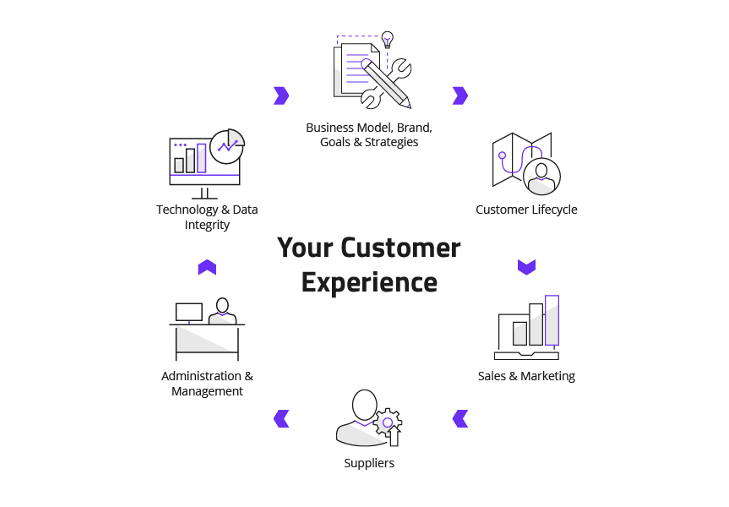B2B Digital Commerce: Planning for 6 Complexities
Jun 01, 2022 • 7 Minute Read • Bill Cronin, Technical Director


There's a balance to strike between meeting the needs of long-standing yet less technically oriented customers and the newer generation of digital natives. It's one thing to meet this challenge head-on, but it's another to do it while maintaining brand integrity and customer loyalty.
It's easy to misplace focus and over-emphasize the different levels of technical prowess and comfort of varying customer types.
However, there's good news—all users share the fundamental goal of having an easy-to-use, accurate, and highly efficient UX and the information they need to help them execute their buyer responsibilities.
This article explores the following areas to help you start expanding your digital commerce practices to align with today's digital trends:
Leave this page with a clear path forward—one that evolves your digital strategy while preserving the legacy, relationships, and unique value that set your business apart. Balancing innovation with tradition is possible, and we’re here to help you make it happen.
Understanding where your business stands today is the essential first step to defining where you want to go, and how to get there. Creating a clear data-driven digital strategy lays the foundation for aligning your business goals with customer needs, helping you achieve long-term success
Digital transformation means different things to different companies.
At Verndale, we define digital transformation as an end-to-end technology solution for one or more defined digital initiatives such as a website, commerce capability, or CRM implementation. The goal of digital transformation is to deliver the fundamental value, expertise, and relevance that you already provide but through improved, more relevant, and efficient means.
Digital transformation can drive increased revenue and operational efficiency and improve margins and profitability. The most effective digital solutions are aligned with existing channels, sales relationships, and business processes while adding intelligent layers to each customer journey touchpoint. Digital interactions are also more measurable and far easier to standardize and scale across a larger set of users including internal CSR/sales users and customers.
For manufacturers and distributors, this could mean adding self-service solutions for your distributors and customers that fully reflect existing and special business terms, policies, and outcomes. These include custom quotes, contract pricing, subscriptions, and time-released orders. It also means giving customers the ability to reference and manage their financial touchpoints through integrated services such as past transaction references, invoice payments, re-ordering, and organized list and quote management.
Digital alignment and standardization of product data through enhanced product information management (PIM) systems can also improve efficiency and accuracy across channels regarding what's sold, while customer-specific solutions, commercial terms, and delivery options continue to support each customer’s unique needs and satisfaction.
Aligning your business and customers is not a one-and-done exercise. Your buyer journeys are ongoing and require continuous improvement cycles to stay current. Keep this in mind as you analyze your positioning within a wider-scoped digital transformation and plan on conducting feedback and infusing enhancements to align digital capabilities with stakeholder expectations.
Investing in impactful digital capabilities and establishing technologies requires a holistic approach. In Verndale's best practices, we advise collecting input from all relevant stakeholders across your organization, market, and core customer types. We've seen companies take shortcuts only to have missed critical requirements and capabilities that are far more costly to re-engineer back into a given solution.
The overarching primary stages against which to capture, develop, and implement an appropriate and holistic digital strategy include where you are today, where you're going, and how/when you'll get there.
These three questions are stepping stones as you examine your customer experience, starting with your current state and your path to discovery, transitioning to your strategy and vision development, and ending with a prioritized and phased implementation.
Every interaction—whether it fosters trust and engagement or sparks doubt and frustration—feeds directly into the overall customer experience. It only takes one misstep for a customer to consider switching to a competitor, making every touchpoint critical.
This delicate balance isn’t limited to a single team or channel. It spans departments and customer touchpoints across the entire business. The digital experience is no longer a siloed responsibility. It’s tightly woven into the broader business experience—and that includes offline interactions as much as online ones. The days of treating digital and physical channels as separate are long gone.
To create a seamless, impactful experience, every team must take ownership of how their role contributes to the overall customer journey. Alignment across departments, platforms, and devices is essential to delivering consistent, high-value interactions at every stage.
The following areas revolve around your customer experience and serve as foundational components for shaping an effective digital strategy.

To build an effective digital strategy, it’s essential to align validation and ownership with the right teams and individuals—both inside and outside your organization. This means working across departments to define clear requirements that can be analyzed, prioritized, and acted upon.
There was a time when digital and commerce experiences were siloed within marketing or ecommerce teams. Today, your website and digital tools represent the entire business. They're no longer just marketing assets; they're strategic business drivers.
As you assess the broader business impact of your digital initiatives, it’s crucial to gather input from all relevant stakeholders. Consolidating these insights into a structured, digestible format allows for more effective decision-making and prioritization.
Ready to dive deeper? Download our white paper, Modernizing Digital Selling, to expand on the insights shared in this article and explore actionable strategies you can bring back to your organization.
Inside, you'll discover how to evolve digital experiences while preserving the legacy value and relationships that set your business apart. The white paper covers:
Use this resource to align teams, modernize your approach, and future-proof your digital selling strategy.
